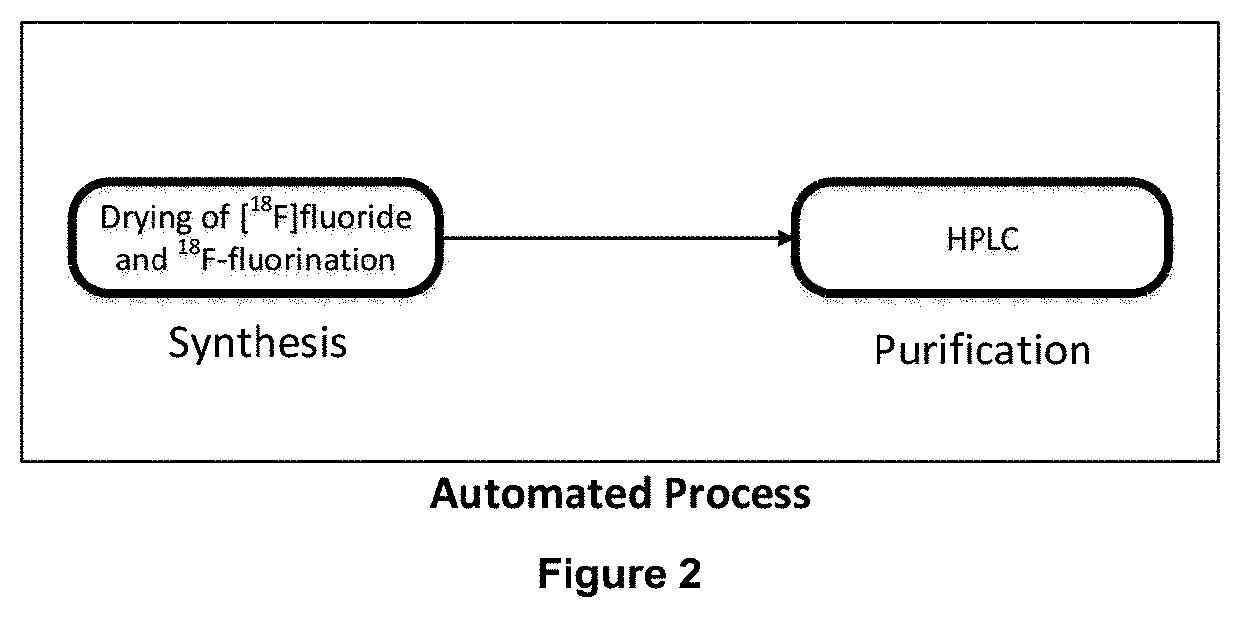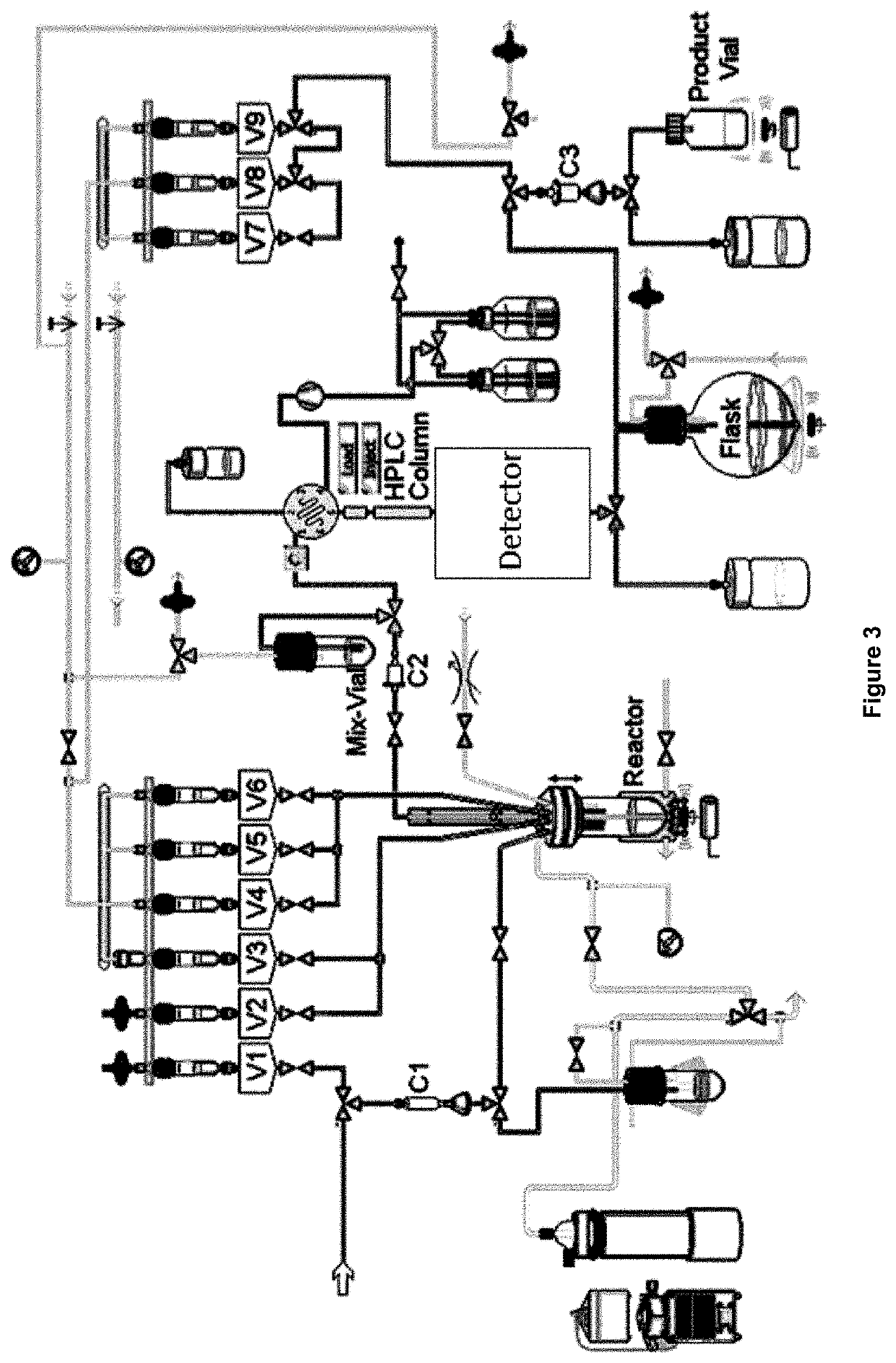Novel method of preparing an imaging compound
- Summary
- Abstract
- Description
- Claims
- Application Information
AI Technical Summary
Benefits of technology
Problems solved by technology
Method used
Image
Examples
example a
Preparative Example A
[0235]
[0236]Step A
[0237]Commercially available 2,6-dibromopyridine (4.12 g, 16.6 mmol) was suspended in ethanol (40 mL) and hydrazine hydrate (10 mL, 97.6 mmol) in water (˜50-60%) was added. The mixture was heated in a sand-bath at ˜115° C. for 18 hours. The solvent was removed and the residue was purified by chromatography on silica using ethyl acetate / n-heptane (60 / 40) to afford the title compound as an off-white solid (3.05 g, 93%).
[0238]1H-NMR (400 MHz, CDCl3): δ=7.33 (t, 1H), 6.83 (d, 1H), 6.67 (d, 1H), 6.00 (br-s, 1H), 3.33-3.00 (br-s, 2H)
[0239]Step B
[0240]The title compound from Step A above (10 g, 53.2 mmol) and commercially available 1-Boc-4-piperidone (10.6 g, 53.2 mmol) were added to a 500 mL flask and mixed to become a homogenous blend. Then polyphosphoric acid (80 g, 115% H3PO4 basis) was added and the mixture was heated at ˜160° C. in a sand-bath. At ˜120° C. the Boc-protecting group was cleaved resulting in foaming of the reaction mixture. After c...
example b
Preparative Example B
[0245]
[0246]Step A
[0247]To a suspension of the title compound from Preparative Example A (0.776 g, 0.72 mmol) in dichloromethane (65 mL) was added triethylamine (1.86 mL, 13 mmol) and trityl-chloride (2.63 g, 9.39 mmol). After the addition of 4-(dimethylamino)-pyridine (0.074 g, 0.608 mmol), the reaction mixture was stirred at room temperature for 16 hours. The reaction mixture was diluted with dichloromethane (150 mL) and water (50 mL). The organic phase was separated, dried over Na2SO4, filtered and the solvents were removed in vacuo. The residue was purified on HP-Sil SNAP cartridges (50 g) using a Biotage Isolera One purification system employing an ethyl acetate / n-heptane gradient (5 / 95->100 / 0->100 / 0) to afford the title compound B as a pale yellow solid (0.831 g, 54%). Unreacted starting material was recovered by flushing the cartridge with ethyl acetate / methanol (90 / 10) to afford the starting material as an off-white solid (0.195 g, 25%).
[0248]1H-NMR (400...
example c
Preparative Example C
[0250]
[0251]Step A
[0252]To a suspension of the title compound from Preparative Example A (0.482 g, 1.94 mmol) in dichloromethane (40 mL) was added triethylamine (1.15 mL, 8 mmol) and 4,4′-(chloro(phenyl)methylene)bis(methoxybenzene) (DMTrt-Cl) (1.963 g, 5.8 mmol). After the addition of 4-(dimethylamino)-pyridine (0.046 g, 0.377 mmol), the reaction mixture was stirred at room temperature for 3 days. The reaction mixture was diluted with dichloromethane (100 mL) and water (40 mL). The organic phase was separated, dried over Na2SO4, filtered and the solvents were removed in vacuo. The residue was purified on HP-Sil SNAP cartridges (50 g) using a Biotage Isolera One purification system employing an ethyl acetate / n-heptane gradient (5 / 95->100 / 0->100 / 0) to afford the title compound C as a pale yellow solid (0.825 g, 72%). Unreacted starting material was recovered by flushing the cartridge with ethyl acetate / methanol (90 / 10) to afford the starting material as an off-wh...
PUM
| Property | Measurement | Unit |
|---|---|---|
| Pressure | aaaaa | aaaaa |
| Pressure | aaaaa | aaaaa |
| Capacitance | aaaaa | aaaaa |
Abstract
Description
Claims
Application Information
 Login to View More
Login to View More - R&D
- Intellectual Property
- Life Sciences
- Materials
- Tech Scout
- Unparalleled Data Quality
- Higher Quality Content
- 60% Fewer Hallucinations
Browse by: Latest US Patents, China's latest patents, Technical Efficacy Thesaurus, Application Domain, Technology Topic, Popular Technical Reports.
© 2025 PatSnap. All rights reserved.Legal|Privacy policy|Modern Slavery Act Transparency Statement|Sitemap|About US| Contact US: help@patsnap.com



